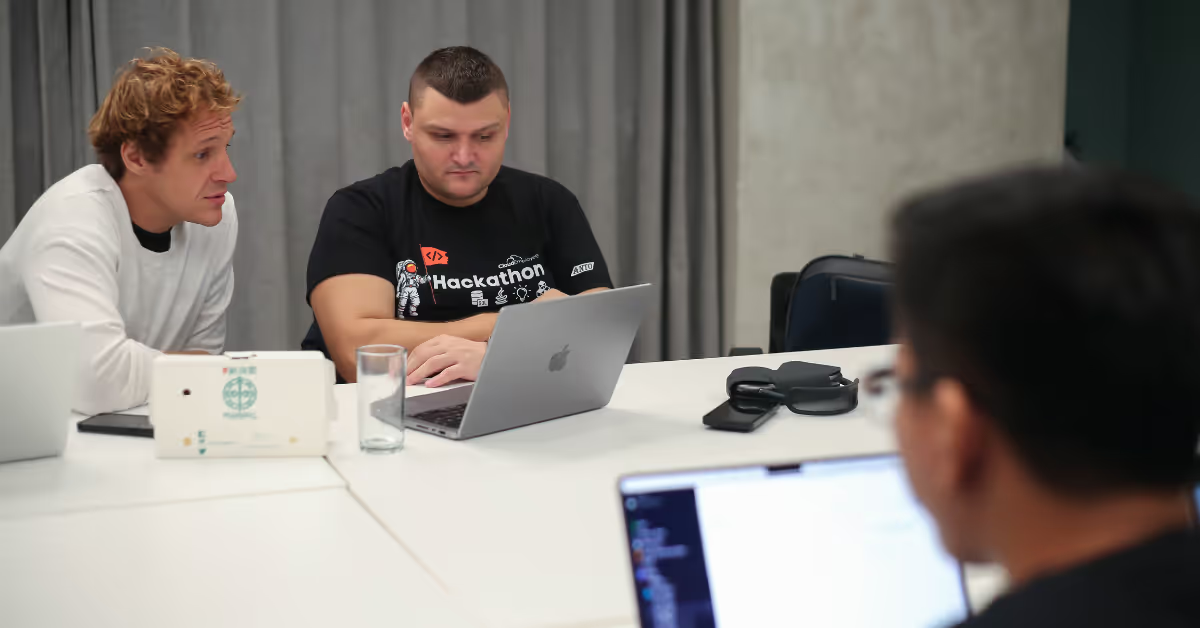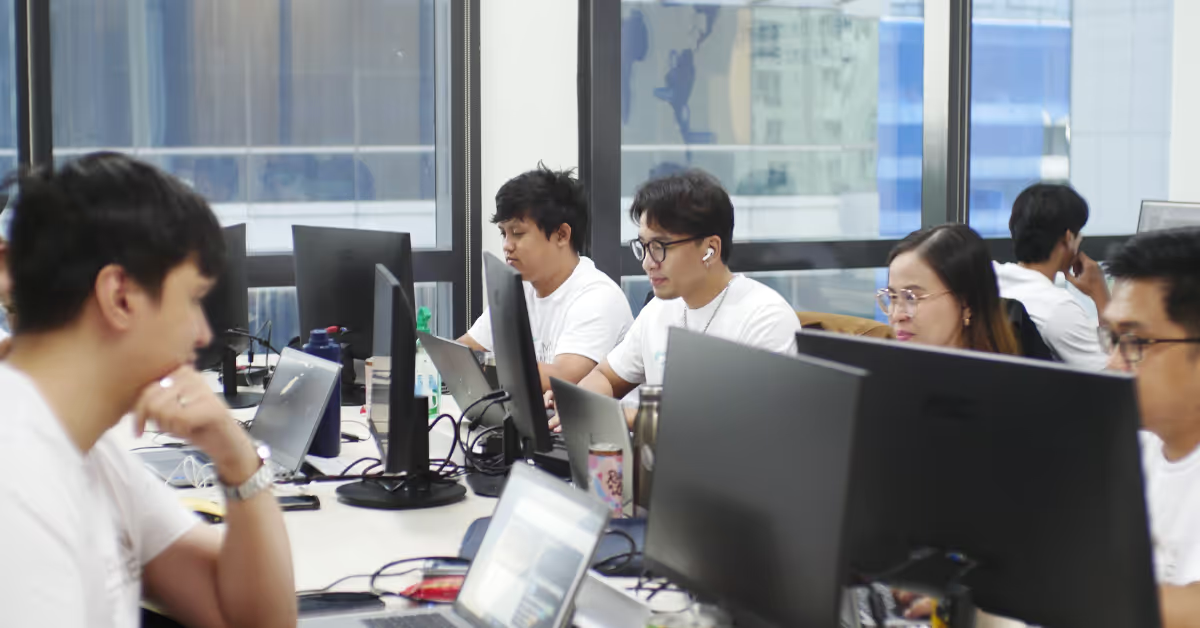Getting onboarding right: Our proven model for successfully onboarding software developers (97%+ retention rate of more than 2 years)

📌 TL;DR
This article explains Cloud Employee’s model for onboarding software developers into specific client teams, whether greenfield or inside existing codebases. It is a repeatable process we use every week to integrate new engineers quickly. You can adopt it internally if you are hiring and onboarding yourself. The model centers on: an expectation-alignment interview the client’s lead, a “How to Work With Us” guide for developers, a visible 90-day success plan, a short onboarding quiz, and a set of early rituals that build trust. The process is supported by our Head of Employee Experience, and our Client Success team who make the journey seamless for both developer and client. It is one reason we sustain a 97%+ retention rate beyond two years and consistent client outcomes.
Why onboarding is strategic, not administrative
CTOs and product leaders do not lose time in month 1 because of coding. They lose it because of ambiguity. When developers join a new project remotely, culture, cadence, expectations, and access are often implied but not written. Our remote software developer onboarding model removes that ambiguity, speeds the first meaningful PR, and protects quality and security from day one. It was built for staff augmentation at scale where outcomes are mission critical. It also functions as a template that internal teams can adopt without change.
In 2025, leaders face simultaneous pressures: deliver roadmap commitments, adopt AI safely, and fill critical skills without inflating fixed costs. The IT skills shortage remains material.
Onboarding is one of the highest ROI levers for retention and productivity. Multiple analyses summarizing Brandon Hall research indicate that structured onboarding can improve new-hire retention by roughly 82% and productivity by 70%+ (strongdm.com). SHRM and Gallup place the cost of replacing a departing employee at roughly 0.5–2.0x annual salary, which makes prevention the smarter spend (SHRM).
Remote work is now standard and onboarding is increasingly digital, but friction persists. Atlassian’s 2024 developer experience research highlights that developers spend much of their week on non-coding work and lose time due to fragmented workflows and unclear information flows. Addressing those friction points in weeks 1–4 is central to our model (TechRadar).
Who we are and why our voice matters
Cloud Employee is a global staff augmentation partner that extends your capacity with top-tier engineers. We embed remote developers into your workflows, tools, and culture while surrounding them with structured support from our Client Success, HR, and Employee Experience functions.
We operate on a staff augmentation model, and clarity here matters:
Staff augmentation definition
Staff augmentation is a flexible workforce model that allows companies to quickly extend their capacity with top-class professionals, without the delays, costs, and risks of traditional hiring. Instead of spending months recruiting in competitive markets, businesses partner with a staff augmentation provider to access the right skills fast.
These professionals work as fully embedded team members, managed by your team. They follow your workflows, adopt your tools, and collaborate daily through the same communication channels as your in-house staff. The key difference is that they are employed overseas or externally through a trusted partner who manages sourcing, HR, payroll, compliance, pension & benefits, L&D, performance monitoring, and retention.
Unlike outsourcing, where a third party takes over full ownership of a function or project, staff augmentation keeps you in control. At its core, staff augmentation is a quality-assured, plug-and-play model that helps businesses remove hiring bottlenecks, buy time, and keep core teams motivated and focused on driving growth.
We have refined onboarding for this specific context: new developers, new or existing client projects, remote-first environments, and a 90-day window where trust is built or lost.
Getting onboarding right is the single highest ROI move a CTO can make in a new engagement. Clarity in week one compounds into velocity in month three.
Seb Hall
CEO and Founder, Cloud Employee
Why this article exists
Two reasons. First, to make explicit how Cloud Employee onboards developers into client teams so you can see why we are confident in our 97%+ retention. Second, to give internal teams a replicable playbook. Everything below is designed to be lifted and run inside your own org.
Our proven developer onboarding model
This is the exact sequence we use for remote developer onboarding and software developer onboarding in staff augmentation. Each step is simple by design.
1) Expectation alignment interview with engineering leaders
We do this before the developer’s start date. A Client Success Manager runs a structured 30–45 minute interview with the client’s CTO, Head of Engineering, or Tech Lead. The goal is to translate knowledge into explicit operating instructions.
What we ask and why
- Business and product context
Simple description of what the company does and what the developer will build or maintain. This frames decisions and tradeoffs. - Culture and working style
Values, pace, meeting etiquette, and what strong collaboration looks like in this team. - Developer success blueprint
The traits and behaviors of top performers here. What would impress you in month one. - Common pitfalls
Past failure patterns to avoid. Examples include waiting for tickets, going silent when blocked, or skipping tests. - Communication and reporting
Who to update, response-time expectations during working hours, and rhythms for standups and reviews. Team locations and time overlap. - Success metrics
What “great” looks like at 30, 60, and 90 days. Specific deliverables and ownership milestones. - Technical and process onboarding
PM methodology, tools, branching strategy, code review etiquette, definition of done, deployment pipeline, and access/security rules.
What we produce
- A concise intake transcript and decisions log.
- A checklist for access and environment setup.
- Inputs for the company-specific guide and the 90-day plan.
This step eliminates ambiguity and ensures we are not “parachuting” developers into a vacuum.
2) The “How to Work With Us” guide
We convert the interview into a practical, developer-facing guide. This is written for action, not for HR.
What is inside
- Company and product in one paragraph
The why, the user, and the quality, security, and performance bar. - Top traits they value
Proactive communication, ownership of delivery, collaborative mindset, suggesting improvements, solid testing discipline, and a growth mindset. - First-month wins
Camera on and present in meetings. Local environment set up. System architecture understood. First meaningful PR with tests. Small contribution to engineering practice improvements. - Communication rhythm and tools
Daily standups kept short and respectful of time. Slack for async. Jira for tickets. GitHub for PRs and reviews. Google Meet for calls. All based on the client’s needs identified. - Communication principles
Acknowledge messages within an hour during working hours. Use camera during calls in the first 90 days. Proactively update the lead rather than waiting to be asked. Challenge scope respectfully when needed. - Ramp-up tasks
Clone repos. Read README and onboarding docs. Architecture walkthrough. Shadow one or two PRs. Pick a small bug or improvement and ship it with tests and documentation. - Security and professionalism
Follow access protocols exactly. Use strong passwords and 2FA. Notify your manager immediately for power or internet issues. Announce if you go offline unexpectedly. - Feedback and growth
Ask for feedback at the end of Week 1 and Month 1. Use a standard message template to request it.
How developers use it
- They read it before day one.
- We walk through it in the onboarding call on day one.
- It is the reference for daily decisions, from how to raise a blocker to how to format a PR.
- It doubles as the checklist for week-one setup and the basis for the onboarding quiz.
3) The 90-day success plan
We turn expectations into visible milestones.
Structure
- Days 1–7
Access complete. Environment working. Architecture overview done. Shadow two PRs. Submit first small PR with tests. - Weeks 2–4
Deliver scoped tickets. Demo progress in sprint review. Apply the team’s definition of done, including test coverage and security gates. - Month 2
Take ownership of a component or service. Lead or co-lead a refinement session. - Month 3
Sustain delivery velocity. Propose at least one engineering improvement. Document a knowledge area for others.
How we make it visible
- A simple EOD form captures work done, blockers, and next steps. Developers submit this daily in minutes.
- A weekly self-scorecard tracks visibility, delivery, collaboration, and learning.
- A monthly reflection records achievements and growth goals.
- Client Success collates signals and shares a concise progress note with the client lead. Everyone sees momentum.
4) The onboarding quiz
A short, interactive quiz ensures the norms are understood. It covers escalation rules, camera etiquette, response times, and agile behaviors.
Examples:
- If a task is unclear, first use ChatGPT to clarify, then ask a teammate or Talent Success, then confirm with the lead.
- If blocked for two hours, escalate to the lead or Cloud Employee team.
- Acknowledge messages as soon as possible during your shift.
- Keep your camera on for calls, especially in your first 90 days, or request permission to turn it off if needed.
Passing score is 15/15. The purpose is clarity, not policing.
5) Rituals that build trust early
These are minimum expectations communicated to every new hire so they understand what good looks like and why the first 90 days matter.
Operating rhythm:
- EOD reports submitted every working day. Three fields: done, blockers, next.
- Weekly self-scorecard posted to the lead and Client Success.
- Monthly self-assessment highlighting outcomes and growth areas.
- Camera on at the start of video meetings. If bandwidth is an issue, ask permission to switch off and explain why.
- Response-time standard is to acknowledge Slack messages within an hour during working hours.
- Escalation rule is to ask a teammate after 30 minutes stuck and escalate to the lead or Cloud Employee team after two hours.
- Challenge respectfully. If scope or deadlines look unrealistic, ask if priorities should be rebalanced.
Why this works
Early visibility reduces stakeholder anxiety and prevents micromanagement. Developers learn the team’s definition of done, and trust grows as demos and PRs land.
The people who make it seamless
- Ericka Go, Head of Employee Experience
Owns our culture of connection by helping new developers build a sense of confidence and belonging within Cloud Employee. Champions well-being initiatives and community events - that foster long term success. - Grace Tannor, Client Success Manager
Runs the expectation-alignment interview, codifies the guide, facilitates the onboarding call, and monitors signals from EOD reports and scorecards. Intervenes early if momentum dips and unblocks access or communication issues fast.
Case study snapshot: onboarding at scale for an enterprise rebuild
A leading enterprise fintech rebuilding a treasury management platform onboarded 11 Cloud Employee developers. The team emphasized quality, security, and performance. The same model above was applied end to end.
Of all the outsourcing companies I’ve worked with in the past, Cloud Employee really impressed me because of all of their backend team: the Client Services team, the Welfare team, the HR team.
Marcus Kilgour
CTO
Leadership quickly saw developers who were not only technically skilled but also seamlessly integrated into the wider team culture - aligned with and adaptable to the CTO’s way of working. They contributed beyond tickets, proactively suggesting improvements to engineering practices.
What our engineers experience and why it drives 97%+ retention
Engineers join with clarity: what great looks like, how to communicate, how to escalate, and how to succeed in 90 days. They also join a connected network, which in their own words, is a core driver of retention as they deliver remote work while remaining connected.
Support they feel
- Community and events that create belonging across accounts.
- Learning and development opportunities curated by our internal Learning and Development team.
- Peer problem-solving through access to other Cloud Employee developers who have solved similar issues.
- Responsive HR and support teams who resolve friction fast, from access to equipment to work environment guidance.
- Structured feedback moments, anchored in the guide.
Why it matters
Developers feel seen and set up to win. The combination of clear expectations, visible progress, and a supportive community translates to long-term engagement, lower attrition, and higher client outcomes.
A 97% retention rate does not happen by accident. It comes from being intentional with regular check-ins, ongoing development opportunities, and a culture backed by community engagement initiatives. It is not always realistic for clients to provide that level of support because time zones, distance, and busy teams get in the way. So we have built our model around it, delivering developers who are fully supported and ready to plug straight into your team.
Grace
Head of Client Success
Best-practice checklist for CTOs and CIOs
Use this as a replicable playbook for onboarding developers remotely in your own org.
- Run an expectation-alignment interview before access is granted. Capture culture, success criteria, pitfalls, review etiquette, and access rules.
- Write a one-page “How to Work With Us” guide for developers. Treat it as operational documentation they will use daily.
- Publish a 90-day success plan with week-one, month-one, and quarter-end milestones. Make it visible with EOD reports, weekly scorecards, and a monthly reflection.
- Use an onboarding quiz to check understanding of communication and security norms.
- Define minimum rituals for the first 90 days: camera on, one-hour acknowledgment rule, escalation timings, and demo cadence.
- Instrument feedback at week 1 and month 1. Use a standard message template to ask for feedback and close the loop.
- Name the support roles. Identify who handles access, who unblocks process issues, and who provides coaching when delivery wobbles.
- Reinforce “think beyond the task.” Ask for at least one improvement suggestion by day 30 and again by day 90.
Our final piece of advice; make week one the strongest week
Remote onboarding is not documentation. It is a sequence of conversations, artifacts, and rituals that remove uncertainty and create early wins. Cloud Employee has tuned this for staff augmentation in high-stakes environments, and the process is simple to adopt internally. If you want a first meaningful PR with tests in the first month, visible momentum in month two, and long-term retention, start with expectation alignment, make success visible, and support the human journey.







.avif)